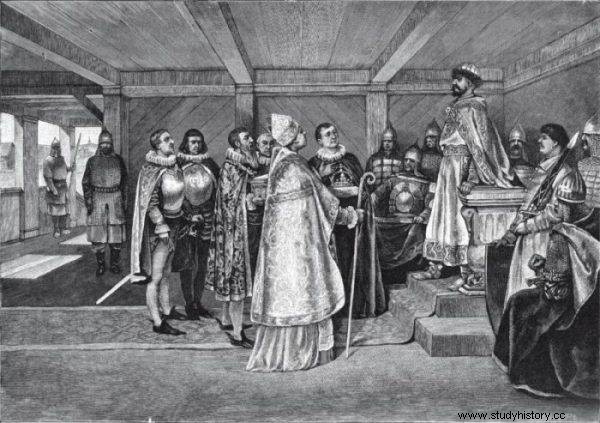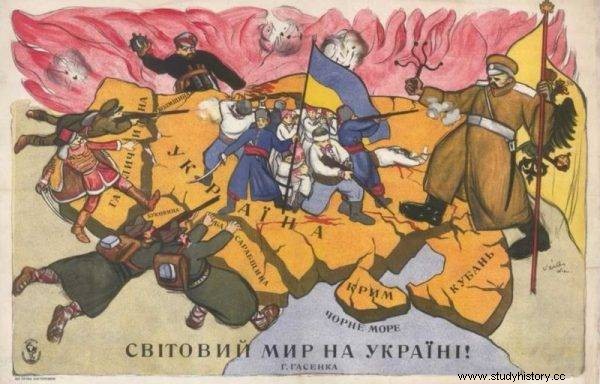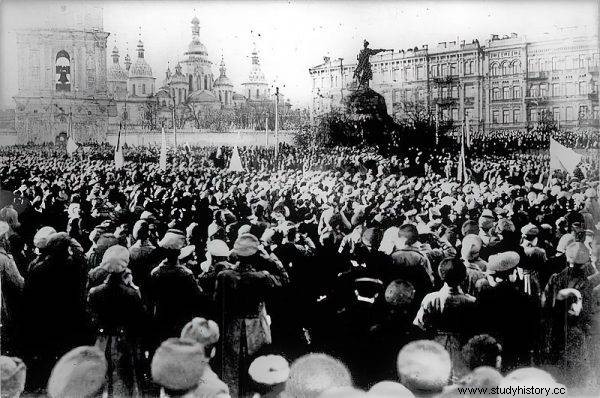Since the end of February, we have been watching the Ukrainians fight the Russians. Today they form unity. So, is it not about two Ukrainians:Eastern and Western?
Let's start from the beginning. Kievan Rus was established around the ninth century. After the death of Jarosław the Wise in 1054, this powerful state began to fragment into district principalities. In the West, it was Ruthenia Halicko-Wołyńska (otherwise Halicko-Włodzimierska). In 1238 it was headed by Daniel I Halicki (ukr. Danyło I Halycki) (1201–1264), the only crowned ruler in the history of Ukraine . First, the capital of the state was Drohiczyn, and then Chełm in the Lublin region. The ruler was related to the Piasts, and Red Ruthenia maintained intense contacts with Western Latin culture. So gradually the division into the West and the East became visible.
In the Middle Ages, Poles and Lithuanians, Tatars, and finally Russians contributed to the fall of the Ruthenian principalities, as it was then said, . Over time, Eastern Ukraine (Ruthenia) fell under the influence of Russia, and Western - of the Republic of Poland. The central one was a place of rivalry between the two countries.
Two capitals, one nation
The time of formation of modern nations, including Ukrainian, but also Polish, for example, falls on the nineteenth century (especially its second half) and the beginning of the twentieth century. During this pivotal period there were indeed two Ukrainians , one under the Russian partition, the other in - then Austrian - Galicia. It would be more correct to write that the Ukrainians lived in two different countries. There were two "Ukrainian capitals":Kyiv and Lviv. The Ukrainians in the Central Committee of the Monarchy had much more opportunities to act for their national identity, culture, science and economic life. In Galicia from the 1860s, there were good conditions for this, because the monarchy guaranteed numerous national freedoms. In Ukraine under Russian rule, it was exactly the opposite. Even the Greek Catholic Church, which became the national Ukrainian Church in Galicia, was banned in Russia.

Daniel I Halicki (Ukrainian:Danyło I Halycki) (1201–1264), the only crowned ruler in the history of Ukraine
Paradoxically, however, the Ukrainian national movement started in Transnistria Ukraine and from there radiated to Galicia. This was, among other things, thanks to the dissemination of the poetry of Taras Shevchenko, the Ukrainian national bard , coming from this part of the country. "The revival of the Ukrainian orientation in Galicia was the result of the conscious work of East Ukrainian patriots who sought to move the center of all-Ukrainian activity here and transform this province into Ukrainian Piedmont" - assessed the Lviv historian, prof. Jarosław Hrycak.
History of Ukraine
Galicia was to be (and was) the center of the revival of Ukrainianness due to the political liberties prevailing here. A serious impulse in the development of Ukrainian national life in the Province was the appointment of the Department of History at the University of Lviv by the young Ukrainian historian Mykhaila Hrushevsky. The greatest work of his life was to write the monumental History of Ukraine . Thus, he proved that a nation without a state also has its history. Two Ukrainians, but still one.
The inhabitants of "both Ukrainians" hoped for the unification of Ukrainian lands in one state. For "Kiev", the new Ukraine was to be part of a democratic, federal Russia. The Bolsheviks, however, forced independence measures, because the new Ukraine did not see itself in the Soviet state. "Lviv", on the other hand, saw a united Ukraine as an autonomous country within the Habsburg state.

Ukrainians lived in two different countries.
At the end of World War I, two Ukrainian states were established. West Ukrainian People's Republic with the capital in Lviv , fighting for its existence with the Poles, she remained loyal to the Central Committee of the Monarchy, and thus found herself in the camp of the losers in the war. Ukrainian People's Republic with the capital in Kiev it fought for survival with the Bolsheviks, striving for an alliance with Poland. What finally happened. Both Ukrainian states entered into a union, trying to combine the eastern element and chaos with Austrian order and bureaucracy.
United Ukraine
In the interwar period, Ukraine was divided again, this time among the Soviets, Poland, Romania, Czechoslovakia / Hungary. Reunification came on September 17, 1939, but not what the Ukrainians expected. For many years, the memory of the war differed in the East and the West, although the official, imposed one was the same. In the East, the "Patriotic War", victory and victims were remembered. The identity of Western Ukrainians was shaped in the memory of the Ukrainian Insurgent Army's fights with the Soviets, deportations and persecution.
In independent Ukraine, the West, especially Lviv and Galicia, wanted to impose their model of patriotism. It was not met with enthusiasm, at least at first. There was a division into the Russian-speaking East, and the Ukrainian-speaking West . Kyiv was in between, but closer to the West. This division became very apparent during the "Orange Revolution". During the elections, the West jointly voted for Viktor Yushchenko and the East for Viktor Yanukovych.

In independent Ukraine, the West, especially Lviv and Galicia, wanted to impose their model of patriotism.
Everything began to change after "Maidan" - "Revolution of Dignity", and especially after Russia's aggression against Ukraine in 2014. There was an accelerated unification, also mental based largely on anti-Russianness. Still only "Westerners" complained about those "Easterners" who still spoke Russian . It turns out, however, that patriots and heroes fighting for Ukraine often speak Russian.
After the victory over Russia, Ukraine will be one, different now, with a different historical memory. As noted by prof. Grigory Yudin, Russian political scientist:"(...) the fact that the conflict that has been ongoing since 2014 has contributed to the creation of a new national and collective identity of the Ukrainian nation. Both of these identities are in stark opposition to Russia and are based on aversion, perhaps even hatred, towards the neighbors. "
